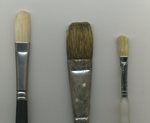Bristle Brushes
Craig Elliott
I have been asked what kinds of brushes I use for oil painting from time to time, so I thought I'd help people understand a bit more about them. Bristle brushes are what I use for most of the painting and for all the beginning stages of my oil paintings.
 Here is a scan 3 of my bristle (hog hair) brushes as a demonstration of their longevity and quality. The left is a brand-new, top of the line Windsor and Newton bristle brush. In the middle is a 15 year old and VERY high quality bristle brush I have been using, and at the right is an unused low quality bristle brush.
Here is a scan 3 of my bristle (hog hair) brushes as a demonstration of their longevity and quality. The left is a brand-new, top of the line Windsor and Newton bristle brush. In the middle is a 15 year old and VERY high quality bristle brush I have been using, and at the right is an unused low quality bristle brush.
The Windsor and Newton and the older brush both should have a nearly endless life unless you are painting on sandpaper! The cheaper brush MIGHT work for a single painting ok, but will never have the kind of control, flex and shape that a good bristle brush does.
The key differences between these 2 qualities of brush are interlocking, and hair arrangement. Interlocking is a term used to refer to the way the bristles are carefully arranged by the maker to have their natural bend curve toward the center of the brush. This is most easily seen on the middle brush because the stains from the old paint, but it is there on the first brush too. Manufacturers will try and trick buyers who do know that this is a mark of quality by one simple trick. They put soap or some other washable stiffener in the hairs and shape them TEMPORARILY to point towards the center. The best way to find out if this is the case is to carefully knead the stiffener out in the store and see if the hairs still do this. The other factor in quality is the way the hairs are arranged to form the shape of the brush. Filbert and round brushes are the easiest brushes to look for this type of quality. Good quality and good performing brushes have whole hairs carefully arranged to make the pointed shape, of say, a round brush. Individual hog bristle hairs all naturally come to a sharp taper and each have a very fine point. When a brush is arranged well all the pointed ends of the hairs will be at the tip of the brush, none will stick out in a stray manner and none will have fuzzy or blunt ends. Cheap hair arrangement (if you can call it that) will have a combination of fuzzy, blunt and sharp hairs. These brushes are often just stuffed with hair, and then SANDED on a power sander to shape them. this creates a terrible brush with hairs that stick out everywhere, fall out on to your painting and have very little control.